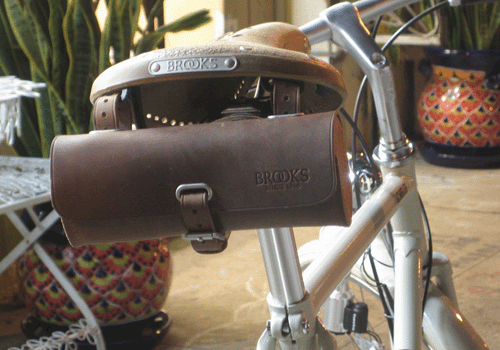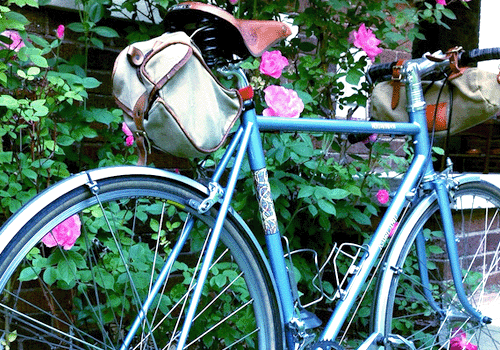Choosing a Bike Saddle Bag

Why I don’t Shout “On Your Left”
July 27, 2018
What’s in Your Cycling First Aid Kit?
August 10, 2018Cycling and commuting to work are great ways to exercise and enjoy the outdoors. Feeling the wind in your face as you pound out the miles on a long straight stretch of road, or getting low as you lean into a curve at 30 mph, cycling is a rush that you WILL get addicted to. As a casual rider or everyday commuter, there will be times when something goes wrong with your bike. Most of the time, it's just a flat tire or one of your cables will break. Other times it could be your crank arm falls off while you are climbing a hill. What can you do to prepare for these issues? Backpacks are great for carrying a lot of stuff, but riding with one on your back can quickly get real heavy and sweaty.
Instead, invest in a saddle bag for your bike. There are tons of choices out there that are guaranteed to fit any size bike you have. Some bags will fit under your seat, below the down tube of your frame, attach to your handlebars, or if you commute or do long distance touring, get a good set of waterproof panniers. Whatever kind of rider you are, follow these guidelines to see which saddle bag will work for you.
Instead, invest in a saddle bag for your bike. There are tons of choices out there that are guaranteed to fit any size bike you have. Some bags will fit under your seat, below the down tube of your frame, attach to your handlebars, or if you commute or do long distance touring, get a good set of waterproof panniers. Whatever kind of rider you are, follow these guidelines to see which saddle bag will work for you.
Choosing a Small Size Bag
If you are a casual rider who cycles down to the grocery store, or short trips along the local bike path; or a seasoned cyclist who cranks out 40 or 60 miles a day, you would want a small sized saddle bag. The Topeak Wedge Saddle Bag fits snugly under your saddle and has adequate enough space for your needs. If you reserve your seat for a saddle mounted water bottle holder, consider using the Bell Stowaway Handlebar Bag for Bicycle bag that attaches to your handlebars. There is also the Aduro Triangle Frame Strap-On Pouch that attaches to the top frame and seat post. Smaller bags like the SLS3 Cycling Top Tube Bag, attach to the top tube of the frame and the post of your handlebars.Pack Light Essentials Only
Your needs for what you want to carry will also dictate the size bag that you need. For city riders, or cyclists who bike in an urban setting, it's best to pack only a few items. A pump, extra tube, patch kit, tire levers and a small toolkit would be all that you need. Anything that can not be fixed by these tools you'll.have to call someone or an Uber to come get you. Riders who cycle more miles or further out into the rural areas will need a few more items. A pump, two extra tubes, patch kit, tire levers, toolkit, external USB battery charger (charged), and a wrench. You could include a hand pump plus a co2 cartridge pump for quick fills, but always have at least a hand pump.Choosing Larger Saddlebags or Panniers
Commuters and long distance riders will need a saddle bag much larger than the ones that fit below the seat or on the handlebars. If you commute to work, a large bike bag like the Roswheel Bike Rack Bag Seat Cargo Bag that attaches to a rear seatpost rack and has room enough for your change of clothes is what you need. The side pockets are plenty large enough to hold your tools. Touring cyclists or cyclist that ride cross country will need the full on panniers, and may need front and rear panniers. The Ibera Bicycle Panniers (Pair) features two large pockets that also come with a rain cover. You will need a bike rack that attaches to the dropout eyelets on your frame and the seat stay. Most panniers are detachable also, allowing you to remove them to take into the office or wherever you are staying overnight while touring.Pack for Where You Are Riding
You will want to pack a little more into your bike bag or panniers than what you carry in a saddle bag. The essentials still go in, bike pump, spare tubes, patch kit, levers and a larger tool kit that includes a wide range of hex wrenches as well as any socket that your bike needs. In addition to these, I'd also add spare bike cables, electrical tape, screwdrivers (regular and phillips head), disposable wipes and spare tire. If you are touring on your bike, pack all of your essentials then add your camping gear then your clothes. You'd rather wear dirty clothes than get in the middle of nowhere and find out your don't have enough spare tubes to get back into town.Proper Installation
Any size bag you choose to buy, be sure to install it properly onto your bike. Having a bag installed incorrectly can be dangerous if it impedes your pedaling or worse, comes loose and cause your to crash. Make sure the bag is installed securely with no straps or bungie ties hanging down that can get caught in your chair or spokes. If you cram too much gear into the bag and it can not zip closed properly, get a larger bag. Once you have installed your bag or panniers, ride around slowly to check that nothing is rubbing against the bag, or that nothing can come loose.Check your Bag Often
After you have installed your bag and added the necessary gear, check it often, daily at first, then weekly to make sure that nothing has come loose. Tighten any bolts or nuts that were used to install the bags and make sure everything is still safe. If one of your bags gets a hole in it or the stitching begins to come loose, replace the bag to avoid any issues that could harm you.Using a saddle bag to carry spare parts and tools will help you cycle further and keep you safe. Any size bag you choose to purchase needs to carry the essentials needed to get you home or somewhere to fix your bike when something breaks. After you have purchased a bag and filled it with what you need, spend time learning how to fix things on your bike. Watch Youtube videos or talk to your local bike shop for instructions. That way, when something goes wrong on the road, you will be prepared to fix it.
Stay safe and keep riding!



